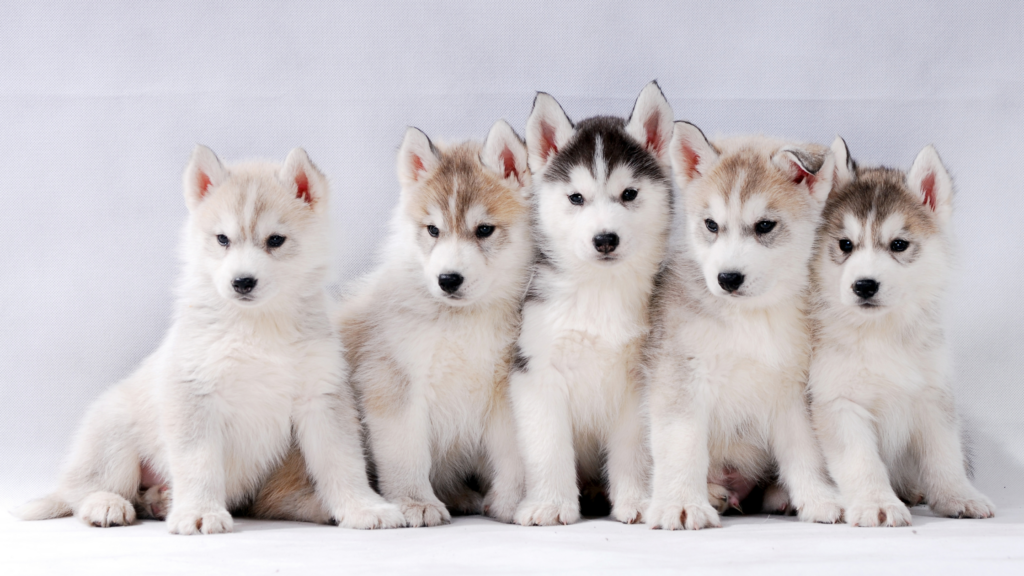Understanding the Growth: How Big Can Huskies Really Get?
Huskies are a breed that never fails to captivate with their striking appearance and boundless energy. As potential husky owners, understanding their growth patterns and how big they can get is crucial for providing them with the best care throughout their life. In this article, we’ll delve into the fascinating journey of a husky’s growth, from puppyhood to adulthood, and provide you with insights to help you anticipate their size.
The Growth Phases of Huskies
Husky growth can be roughly divided into three phases: puppyhood, adolescence, and adulthood. Let’s take a closer look at each phase and what you can expect in terms of size.
Puppyhood (0-6 Months)
During the first six months of life, husky puppies experience rapid growth. Their size can increase dramatically, and you’ll likely notice changes almost daily. Here’s a general idea of the growth rate during this phase:
| Age (Months) | Average Weight (Male) | Average Weight (Female) | Average Height (Male) | Average Height (Female) |
| 2 | 15-20 pounds (7-9 kg) | 15-20 pounds (7-9 kg) | 11-14 inches (28-36 cm) | 11-14 inches (28-36 cm) |
| 4 | 25-35 pounds (11-16 kg) | 20-30 pounds (9-14 kg) | 15-18 inches (38-46 cm) | 15-18 inches (38-46 cm) |
| 6 | 35-50 pounds (16-23 kg) | 25-40 pounds (11-18 kg) | 18-20 inches (46-51 cm) | 17-19 inches (43-48 cm) |
Keep in mind that these are approximate averages. Genetics and individual factors can cause some variation in size.
Adolescence (6-18 Months)
During adolescence, huskies continue to grow, but at a slower rate than during puppyhood. Their bodies become more proportional, and their muscle mass increases. Here’s what to expect during this phase:
| Age (Months) | Average Weight (Male) | Average Weight (Female) | Average Height (Male) | Average Height (Female) |
| 9 | 45-60 pounds (20-27 kg) | 35-50 pounds (16-23 kg) | 20-22 inches (51-56 cm) | 19-21 inches (48-53 cm) |
| 12 | 50-65 pounds (23-29 kg) | 40-55 pounds (18-25 kg) | 21-23 inches (53-58 cm) | 20-22 inches (51-56 cm) |
| 18 | 55-75 pounds (25-34 kg) | 45-65 pounds (20-29 kg) | 23-24 inches (58-61 cm) | 21-23 inches (53-58 cm) |
Adulthood (18+ Months)
Around 18 months, most huskies have reached their full height, although they might continue to fill out in terms of muscle mass. Here’s what you can generally expect in terms of size:
| Age (Months) | Average Weight (Male) | Average Weight (Female) | Average Height (Male) | Average Height (Female) |
| 24 | 60-70 pounds (27-32 kg) | 35-60 pounds (16-27 kg) | 23-24 inches (58-61 cm) | 20-23 inches (51-58 cm) |
Factors Affecting Growth
The growth of a Husky is a dynamic process influenced by a combination of factors that work in harmony to shape their size, physique, and overall development. Understanding these factors is crucial for providing optimal care and ensuring your Husky reaches their full potential. Let’s delve into the key factors that affect Husky growth:
Diet and Nutrition
Proper nutrition is a cornerstone of healthy growth. A balanced diet rich in essential nutrients, including protein, vitamins, and minerals, is vital for supporting bone and muscle development. During the growth stages, Huskies have high energy requirements, and providing them with the right nutrients lays the foundation for their overall well-being.
Exercise and Activity
Physical activity plays a pivotal role in shaping your Husky’s growth. While exercise is essential for building strong muscles and bones, striking the right balance is crucial. Excessive or intense exercise during the growth stages can potentially lead to joint issues. Regular, moderate exercise that encourages muscle development without straining growing joints is recommended.
Health and Healthcare
Routine veterinary care is integral to monitoring your Husky’s growth progress. Regular check-ups allow veterinarians to track growth patterns, identify any abnormalities, and provide guidance on adjustments to diet and exercise. Addressing health concerns promptly ensures that potential growth-related issues are identified and managed early.
Breed-Specific Factors
Each breed, including Huskies, has specific growth patterns and timelines. Understanding the breed-specific growth rate and expected size helps set realistic expectations for your Husky’s development. Huskies are known for their distinctive physique, and being aware of these breed characteristics guides your understanding of their growth journey.
Genetics and Inheritance
Genetic factors inherited from a Husky’s parents and lineage play a significant role in their growth. Genes determine the potential size a Husky can reach, but they can also lead to variations within the breed standard. Studying the genetics of your Husky’s lineage can provide insights into their growth potential.
Average Husky Size
Huskies, with their striking appearance and captivating demeanor, come in a range of sizes that contribute to their unique charm. Understanding the average size of a Husky provides valuable insights into their physical characteristics and helps you appreciate their individuality within the breed. Let’s explore the average size of male and female Huskies and gain a deeper understanding of their dimensions.
| Breed | Average Height (Male) | Average Height (Female) | Average Weight (Male) | Average Weight (Female) |
| Siberian Husky | 21-24 inches (53-61 cm) | 20-22 inches (51-56 cm) | 45-60 pounds (20-27 kg) | 35-50 pounds (16-23 kg) |
| Labrador Retriever | 22.5-24.5 inches (57-62 cm) | 21.5-23.5 inches (55-60 cm) | 65-80 pounds (29-36 kg) | 55-70 pounds (25-32 kg) |
| Golden Retriever | 23-24 inches (58-61 cm) | 21.5-22.5 inches (55-57 cm) | 65-75 pounds (29-34 kg) | 55-65 pounds (25-29 kg) |
| German Shepherd | 24-26 inches (61-66 cm) | 22-24 inches (56-61 cm) | 65-90 pounds (29-41 kg) | 50-70 pounds (23-32 kg) |
| Beagle | 13-15 inches (33-38 cm) | 13-15 inches (33-38 cm) | 20-30 pounds (9-14 kg) | 20-30 pounds (9-14 kg) |
| Bulldog (English) | 16-20 inches (41-51 cm) | 14-18 inches (36-46 cm) | 50 pounds (23 kg) | 40 pounds (18 kg) |
Male Husky Size
Male Huskies generally stand taller and have a larger build compared to their female counterparts. On average, a fully grown male Husky typically measures between 21 to 24 inches (53 to 61 cm) at the shoulder. Their weight falls within the range of 45 to 60 pounds (20 to 27 kg). This variance in size is influenced by genetics, diet, exercise, and other individual factors.
Female Husky Size
Female Huskies are generally smaller in size compared to males. On average, a fully grown female Husky stands between 20 to 22 inches (51 to 56 cm) at the shoulder. Their weight ranges from 35 to 50 pounds (16 to 23 kg). Just like males, the size of female Huskies can vary based on genetics and lifestyle factors.
Comparing to Other Dog Breeds
When comparing Husky sizes to other dog breeds, it’s important to recognize that there is a considerable range of sizes within the canine world. Huskies fall into the medium-sized category, with their average height and weight falling within the ranges mentioned above. Their build is well-suited for their working heritage, enabling them to perform tasks such as pulling sleds in challenging Arctic conditions.
Recognizing Abnormal Growth
As a responsible Husky owner, it’s essential to be attuned to your furry companion’s growth journey. While growth is a natural and exciting process, it’s important to recognize when growth patterns deviate from the norm. Identifying abnormal growth early can lead to timely intervention and better outcomes for your Husky’s health and well-being. Here’s a guide to help you recognize signs of abnormal growth and take appropriate action:
Disproportionate Growth
If you notice that your Husky’s limbs or body parts are growing at significantly different rates, it could indicate an abnormality. For example, an unusually long or short leg, or a disproportionate torso, should be examined by a veterinarian.
Rapid or Excessive Growth
While some growth spurts are expected, excessively rapid growth can lead to health issues, especially in larger breeds like Huskies. Sudden weight gain and increased height within a short period can strain bones and joints.
Delayed Growth
If your Husky’s growth seems to be lagging behind their age, it’s a cause for concern. Delayed growth could result from nutritional deficiencies, health problems, or developmental issues.
Joint or Bone Abnormalities
Uneven joint growth, visible or palpable lumps on bones, or irregularities in the spine could indicate underlying skeletal problems. These issues might need to be evaluated by a veterinarian.
Behavioral Changes
Sometimes, abnormal growth is accompanied by changes in behavior. If your Husky becomes lethargic, experiences discomfort, or displays signs of pain during physical activity, it’s crucial to investigate the cause.
Tips for Supporting Healthy Growth

Ensuring the healthy growth and development of your Husky is a rewarding responsibility that contributes to their overall well-being and vitality. From puppyhood to adulthood, there are several key strategies you can implement to support their growth journey. Here are valuable tips for fostering optimal growth in your beloved Husky:
High-Quality Nutrition
Providing a balanced and nutritious diet is essential for your Husky’s growth. Choose high-quality dog food formulated for their specific life stage (puppy, adult, senior) and size. Look for ingredients that offer essential nutrients like protein, vitamins, and minerals to promote bone, muscle, and overall development.
Portion Control
While it’s important to feed your Husky enough to support growth, avoid overfeeding. Follow the feeding guidelines on the dog food packaging based on their age, weight, and activity level. Overfeeding can lead to excessive weight gain and strain developing joints.
Consult Your Veterinarian
Regular veterinary check-ups are crucial for monitoring your Husky’s growth progress. Your veterinarian can offer guidance on proper nutrition, assess your Husky’s overall health, and provide personalized recommendations based on their individual needs.
Age-Appropriate Exercise
Exercise is vital for building strong muscles, bones, and promoting overall health. However, tailor the intensity and duration of exercise to your Husky’s age. Puppies should engage in controlled play and short walks to prevent stress on growing joints. Gradually increase exercise as they mature.
Socialization and Mental Stimulation
Healthy growth encompasses mental and emotional well-being. Engage your Husky in socialization and mental stimulation activities. Exposing them to different environments, people, and dogs helps build confidence and mental agility.
Conclusion
Understanding how big Huskies can get is not only intriguing but also pivotal in providing optimal care. By being proactive and informed, you’re setting the stage for a healthy, vibrant, and well-sized Husky that will be your cherished companion for years to come.
Ready to Give Your Husky the Best Start in Life?
Fostering healthy growth and ensuring your Husky thrives requires a combination of knowledge, care, and dedication. Whether you’re a new or experienced Husky owner, the journey of nurturing your pup’s growth is both rewarding and fulfilling.
For expert tips, advice, and comprehensive guidance on caring for your Husky from puppyhood to adulthood, look no further than YourPetLand. Discover a wealth of resources, including valuable insights into nutrition, exercise, grooming, and all aspects of Husky care. Whether you’re navigating the stages of growth or seeking tailored advice, YourPetLand is your trusted companion on this incredible journey.

